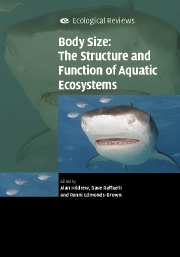Book contents
- Frontmatter
- Contents
- List of contributors
- Preface
- 1 The metabolic theory of ecology and the role of body size in marine and freshwater ecosystems
- 2 Body size and suspension feeding
- 3 Life histories and body size
- 4 Relationship between biomass turnover and body size for stream communities
- 5 Body size in streams: macroinvertebrate community size composition along natural and human-induced environmental gradients
- 6 Body size and predatory interactions in freshwaters: scaling from individuals to communities
- 7 Body size and trophic cascades in lakes
- 8 Body size and scale invariance: multifractals in invertebrate communities
- 9 Body size and biogeography
- 10 By wind, wings or water: body size, dispersal and range size in aquatic invertebrates
- 11 Body size and diversity in marine systems
- 12 Interplay between individual growth and population feedbacks shapes body-size distributions
- 13 The consequences of body size in model microbial ecosystems
- 14 Body size, exploitation and conservation of marine organisms
- 15 How body size mediates the role of animals in nutrient cycling in aquatic ecosystems
- 16 Body sizes in food chains of animal predators and parasites
- 17 Body size in aquatic ecology: important, but not the whole story
- Index
- References
15 - How body size mediates the role of animals in nutrient cycling in aquatic ecosystems
Published online by Cambridge University Press: 02 December 2009
- Frontmatter
- Contents
- List of contributors
- Preface
- 1 The metabolic theory of ecology and the role of body size in marine and freshwater ecosystems
- 2 Body size and suspension feeding
- 3 Life histories and body size
- 4 Relationship between biomass turnover and body size for stream communities
- 5 Body size in streams: macroinvertebrate community size composition along natural and human-induced environmental gradients
- 6 Body size and predatory interactions in freshwaters: scaling from individuals to communities
- 7 Body size and trophic cascades in lakes
- 8 Body size and scale invariance: multifractals in invertebrate communities
- 9 Body size and biogeography
- 10 By wind, wings or water: body size, dispersal and range size in aquatic invertebrates
- 11 Body size and diversity in marine systems
- 12 Interplay between individual growth and population feedbacks shapes body-size distributions
- 13 The consequences of body size in model microbial ecosystems
- 14 Body size, exploitation and conservation of marine organisms
- 15 How body size mediates the role of animals in nutrient cycling in aquatic ecosystems
- 16 Body sizes in food chains of animal predators and parasites
- 17 Body size in aquatic ecology: important, but not the whole story
- Index
- References
Summary
Introduction
Aquatic ecosystems have been fertile ground for understanding the extent to which animals can alter nutrient cycling. Although animals have been included in ecosystem models for years (for example, Teal, 1962), it is only more recently that investigators have looked at animals, either as individuals, single species, or assemblages, as agents regulating nutrient cycling (Kitchell et al., 1979; Meyer, Schultz & Helfman, 1983; Grimm, 1988; Jones & Lawton, 1995). A recent review details how animals can affect nutrient cycling in freshwater ecosystems (Vanni, 2002), but the next step is to understand the controls on which animals are important regulators of nutrient dynamics in ecosystems. One controlling factor is determined by attributes of the animals themselves, such as their body size.
Animals can regulate nutrient cycling directly or indirectly (Kitchell et al., 1979; Vanni, 2002). Direct regulation is the transformation and transportation of nutrients by animal ingestion, egestion, production and excretion. For example, animal excretion can constitute the largest source of plant-available nitrogen (N) within an ecosystem (Hall, Tank & Dybdahl, 2003) and animals can move nutrients between habitats (Meyer et al., 1983). Perhaps more common are indirect controls, whereby animals alter nutrient cycling by changing the biomass, production or distribution of the plants or microbes that take up nutrients. For example, predatory fish can regulate phosphorus (P) dynamics or nitrogen retention via a trophic cascade (Elser et al., 1998; Simon et al., 2004).
- Type
- Chapter
- Information
- Body Size: The Structure and Function of Aquatic Ecosystems , pp. 286 - 305Publisher: Cambridge University PressPrint publication year: 2007
References
- 47
- Cited by



